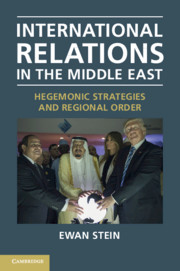Book contents
- International Relations in the Middle East
- International Relations in the Middle East
- Copyright page
- Contents
- 1 Introduction
- 2 The Order of Notables (1919–1952)
- 3 Arab Neutralism and the Cold War (1952–1967)
- 4 Towards a Middle Eastern State Conglomerate (1967–1979)
- 5 Regional Order in Khomeini’s Shadow (1979–1990)
- 6 A New Middle Eastern Order? (1990–2001)
- 7 The Middle East and the Global War on Terror (2001–2011)
- 8 Regional Order after the Arab Uprisings (2011–2020)
- 9 Conclusion
- Bibliography
- Index
7 - The Middle East and the Global War on Terror (2001–2011)
Published online by Cambridge University Press: 28 January 2021
- International Relations in the Middle East
- International Relations in the Middle East
- Copyright page
- Contents
- 1 Introduction
- 2 The Order of Notables (1919–1952)
- 3 Arab Neutralism and the Cold War (1952–1967)
- 4 Towards a Middle Eastern State Conglomerate (1967–1979)
- 5 Regional Order in Khomeini’s Shadow (1979–1990)
- 6 A New Middle Eastern Order? (1990–2001)
- 7 The Middle East and the Global War on Terror (2001–2011)
- 8 Regional Order after the Arab Uprisings (2011–2020)
- 9 Conclusion
- Bibliography
- Index
Summary
The American response to 9/11 sharpened the hostility between the two main antagonistic regional blocs and all but eliminated the possibility that either Iran or Syria might retreat from the hegemonic strategy of maintaining an ‘Axis of Resistance’ in favour of pursuing rapprochement with the West. The George W. Bush administration’s Global War on Terror (GWoT), launched in the wake of the attacks, promised assistance to authoritarian regimes that would join the United States in confronting an amorphously defined ‘terrorism’ in the Middle East and beyond. Three central dynamics underpinned regional order in the Middle East during the first decade of the new millennium. The first was the contestation between Iran and Saudi Arabia for Western favour. The second was the Arab–Israeli conflict, in which non-Arab Iran had become a central protagonist. The third was a competitive dynamic for Western support between between Turkey and Egypt. The chapter considers each of these dynamics in turn.
- Type
- Chapter
- Information
- International Relations in the Middle EastHegemonic Strategies and Regional Order, pp. 161 - 182Publisher: Cambridge University PressPrint publication year: 2021

